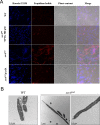Trans-translation is essential in the human pathogen Legionella pneumophila
- PMID: 27892503
- PMCID: PMC5124942
- DOI: 10.1038/srep37935
Trans-translation is essential in the human pathogen Legionella pneumophila
Abstract
Trans-translation is a ubiquitous bacterial mechanism for ribosome rescue in the event of translation stalling. Although trans-translation is not essential in several bacterial species, it has been found essential for viability or virulence in a wide range of pathogens. We describe here that trans-translation is essential in the human pathogen Legionella pneumophila, the etiologic agent of Legionnaire's disease (LD), a severe form of nosocomial and community-acquired pneumonia. The ssrA gene coding for tmRNA, the key component of trans-translation, could not be deleted in L. pneumophila. To circumvent this and analyse the consequences of impaired trans-translation, we placed ssrA under the control of a chemical inducer. Phenotypes associated with the inhibition of ssrA expression include growth arrest in rich medium, hampered cell division, and hindered ability to infect eukaryotic cells (amoebae and human macrophages). LD is often associated with failure of antibiotic treatment and death (>10% of clinical cases). Decreasing tmRNA levels led to significantly higher sensitivity to ribosome-targeting antibiotics, including to erythromycin. We also detected a higher sensitivity to the transcription inhibitor rifampicin. Both antibiotics are recommended treatments for LD. Thus, interfering with trans-translation may not only halt the infection, but could also potentiate the recommended therapeutic treatments of LD.
Figures






References
-
- Poehlsgaard J. & Douthwaite S. The bacterial ribosome as a target for antibiotics. Nat. Rev. Microbiol. 3, 870–881 (2005). - PubMed
-
- Tenson T. & Mankin A. Antibiotics and the ribosome. Mol. Microbiol. 59, 1664–1677 (2006). - PubMed
-
- Moore S. D. & Sauer R. T. Ribosome rescue: tmRNA tagging activity and capacity in Escherichia coli. Mol. Microbiol. 58, 456–466 (2005). - PubMed
-
- Tenson T. & Ehrenberg M. Regulatory Nascent Peptides in the Ribosomal Tunnel. Cell 108, 591–594 (2002). - PubMed
Publication types
MeSH terms
Substances
LinkOut - more resources
Full Text Sources
Other Literature Sources
Research Materials

